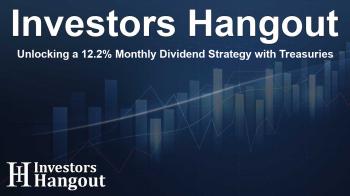Unlocking a 12.2% Monthly Dividend Strategy with Treasuries

Exploring a Remarkable 12.2% Monthly Dividend
Today, we're diving into an exciting 12.2% monthly dividend opportunity that could be a game-changer for your investment strategy.
What fuels this lucrative income? It combines safe U.S. Treasuries with additional earnings from carefully selected options. Let's unpack how this works.
Many investors might have overlooked Treasuries as a viable option, especially when economic uncertainties arise. The government’s significant debt, which has now exceeded $36 trillion, has many questioning the security of lending to such a borrower.
However, bond investors are still engaging with Uncle Sam, albeit now demanding higher returns due to increased credit risk reflected in higher yield expectations. Generally, marketable debt primarily consists of long-term bonds, which are favored by pension funds and other significant investors.
Currently, the 10-year Treasury bond yields only 4.3%. Despite expectations for higher returns, market conditions influenced by government policy have kept yields lower than they might otherwise be. This situation creates an interesting contrast between demand and the government’s capacity to issue debt.
It’s been noted that the Treasury Department has leaned heavily on short-term debt issuance to manage borrowing. While this strategy enjoys temporary accolades, it could pose long-term risks, particularly concerning higher interest payments for federal debt in the future.
Current Treasury Management Under Scott Bessent
Taking charge of the Treasury, Scott Bessent is advocating for a fresh approach compared to his predecessor. This shift in policy reflects an effort to stabilize the yield of longer-term bonds.
Bessent’s approach remains focused on maintaining a limit on long-term yields, a strategy that could support bond funds like the iShares 20+ Year Treasury Bond ETF (NASDAQ: TLT), currently providing a yield of about 4.6%.
This ETF yields are influenced by Federal Reserve movements, and while a decrease in rates might typically lower short-term yields, the long end of the curve may not experience the same adjustments due to investor sentiment.
The previous year showed an intriguing trend where despite rate cuts, long-term yields increased due to rising inflation expectations. Thus, it’s crucial to recognize the bond market’s sensitivity to shifts in policy and investor confidence.
Finding Opportunities in TLT vs. TLTW
Considering a 4.6% yield, there may be better alternatives that align with a monthly payout strategy. One such option is the newer ETF, the iShares 20+ Year Treasury Bond BuyWrite Strategy ETF (NYSE: TLTW).
This fund enhances returns beyond traditional Treasury yields. By engaging in selling covered call options on TLT, TLTW generates an impressive income stream of 12.2%. This structure is appealing, particularly for those looking for consistent monthly income.
The Mechanics Behind TLTW's Yield
Investing $100,000 in TLT provides $4,600 in annual income. In contrast, putting the same amount into TLTW raises your earnings to $12,200 annually. This approach not only creates a robust monthly payout but also engages in the upside potential of TLT through option strategies.
The fundamental principle here is relatively straightforward: Acquire TLT shares and sell covered calls to generate additional yield. This distinct strategy capitalizes on the current market conditions while positioning investors for substantial regular income.
Next time you hear analysts discussing the nuances of Treasuries, remember that strategies like TLTW could serve you well, turning perceived market volatility into profitable opportunities.
In conclusion, whether you trust Treasuries or prefer other 8%+ monthly dividend options, the aim is unwavering—allowing your investments to replace your income stream and meet financial obligations seamlessly.
Frequently Asked Questions
1. What is the primary benefit of TLTW over TLT?
The key advantage of TLTW is its enhanced yield of 12.2% generated through covered call options compared to TLT's 4.6% yield, allowing for greater monthly income.
2. How does the Treasury's debt influence bond yields?
The significant U.S. debt level leads to greater credit risk, prompting investors to demand higher yields, particularly for long-term bonds issued by the government.
3. Can I rely on Treasuries for income?
Yes, Treasuries can provide a secure income stream, but utilizing strategies such as those offered by TLTW can significantly enhance that income potential.
4. What is the function of selling covered calls?
Selling covered calls allows investors to generate additional income from their asset holdings, enhancing total returns while enjoying potential capital appreciation.
5. How does the yield of TLTW compare to other investment options?
TLTW's yield of 12.2% is quite competitive when compared to traditional monthly dividend payers, making it an attractive option for income-focused investors.
About The Author
Contact Henry Turner privately here. Or send an email with ATTN: Henry Turner as the subject to contact@investorshangout.com.
About Investors Hangout
Investors Hangout is a leading online stock forum for financial discussion and learning, offering a wide range of free tools and resources. It draws in traders of all levels, who exchange market knowledge, investigate trading tactics, and keep an eye on industry developments in real time. Featuring financial articles, stock message boards, quotes, charts, company profiles, and live news updates. Through cooperative learning and a wealth of informational resources, it helps users from novices creating their first portfolios to experts honing their techniques. Join Investors Hangout today: https://investorshangout.com/
The content of this article is based on factual, publicly available information and does not represent legal, financial, or investment advice. Investors Hangout does not offer financial advice, and the author is not a licensed financial advisor. Consult a qualified advisor before making any financial or investment decisions based on this article. This article should not be considered advice to purchase, sell, or hold any securities or other investments. If any of the material provided here is inaccurate, please contact us for corrections.

